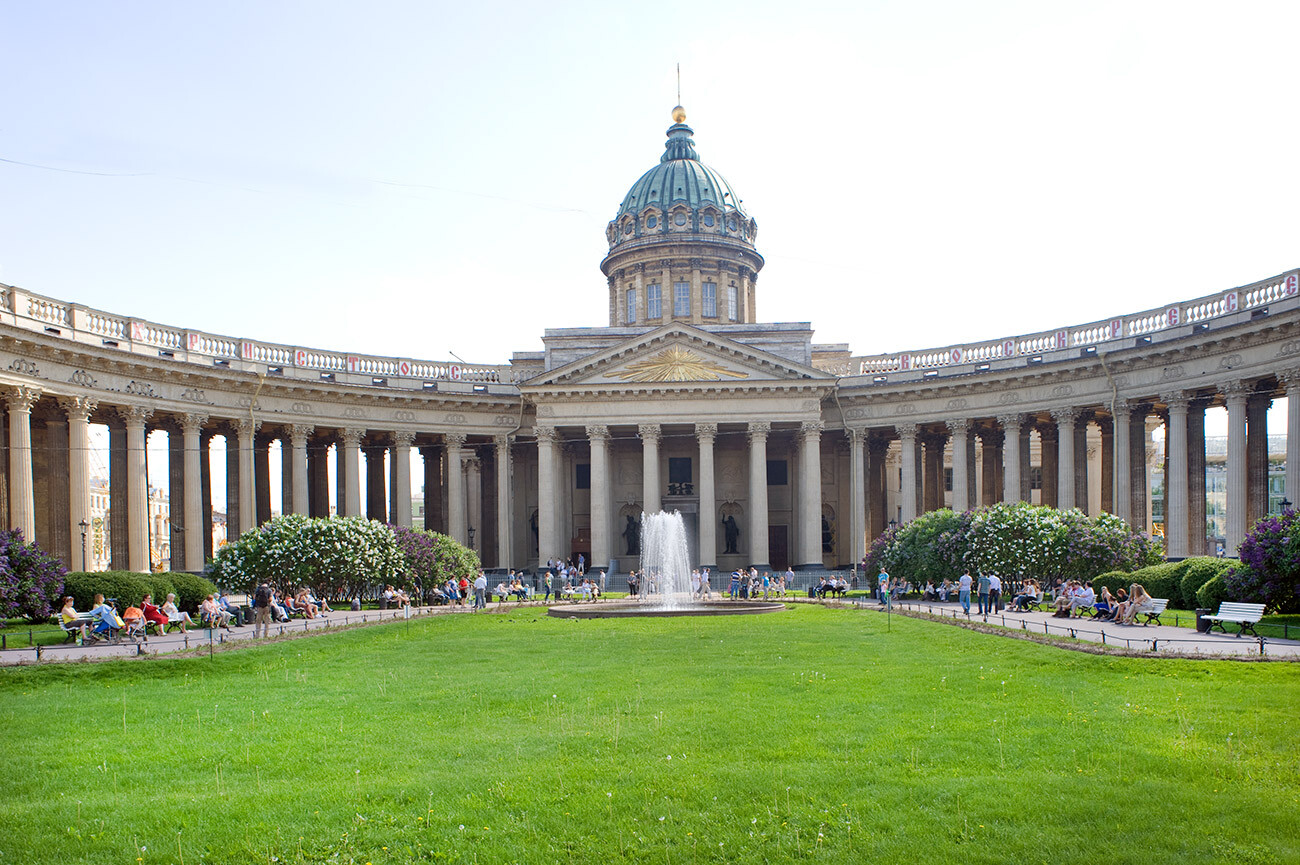
St. Petersburg. Cathedral of Kazan Icon of the Virgin. North view on Nevsky Prospekt. May 31, 2013
William BrumfieldAt the beginning of the 20th century, Russian chemist and photographer Sergey Prokudin-Gorsky invented a complex process for vivid, detailed color photography. His vision of photography as a form of education and enlightenment was demonstrated with special clarity through his photographs of architectural monuments in the historic sites throughout the Russian heartland. The main part of the Prokudin-Gorsky collection ultimately became a part of The Library of Congress.
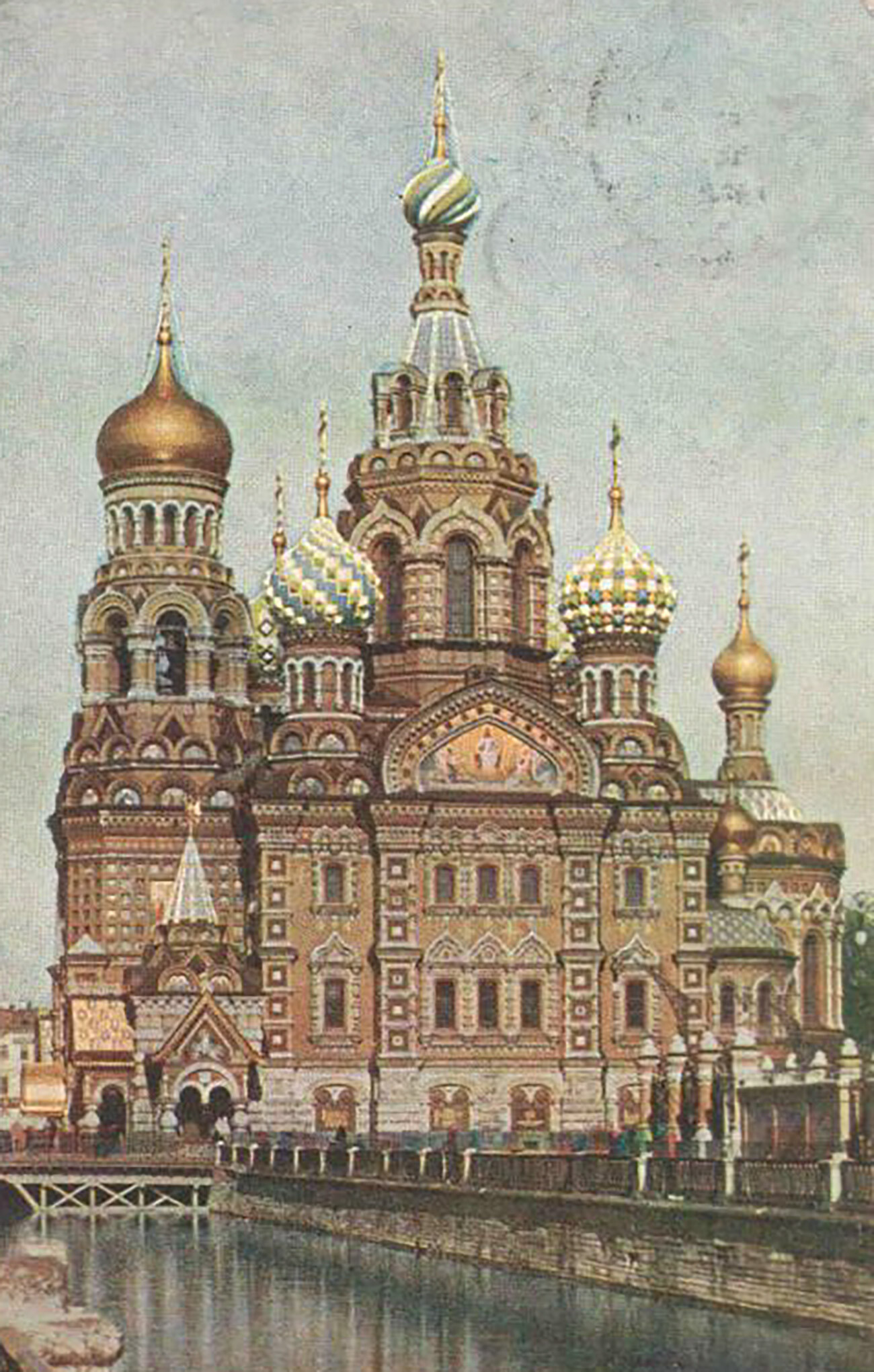
St. Petersburg. Cathedral of Resurrection of Savior on the Blood. South view from Catherine Canal. Circa 1907
Sergey Prokudin-GorskyProkudin-Gorsky also established a business that produced color postcards and illustrations in books. This published work included color photographs - presumably taken in 1907 - of one of the most famous monuments in St. Petersburg, known as the Cathedral of the Savior on the Blood (1883–1907), because of its construction on the Catherine Canal embankment where Tsar Alexander II was assassinated by terrorists in March 1881.
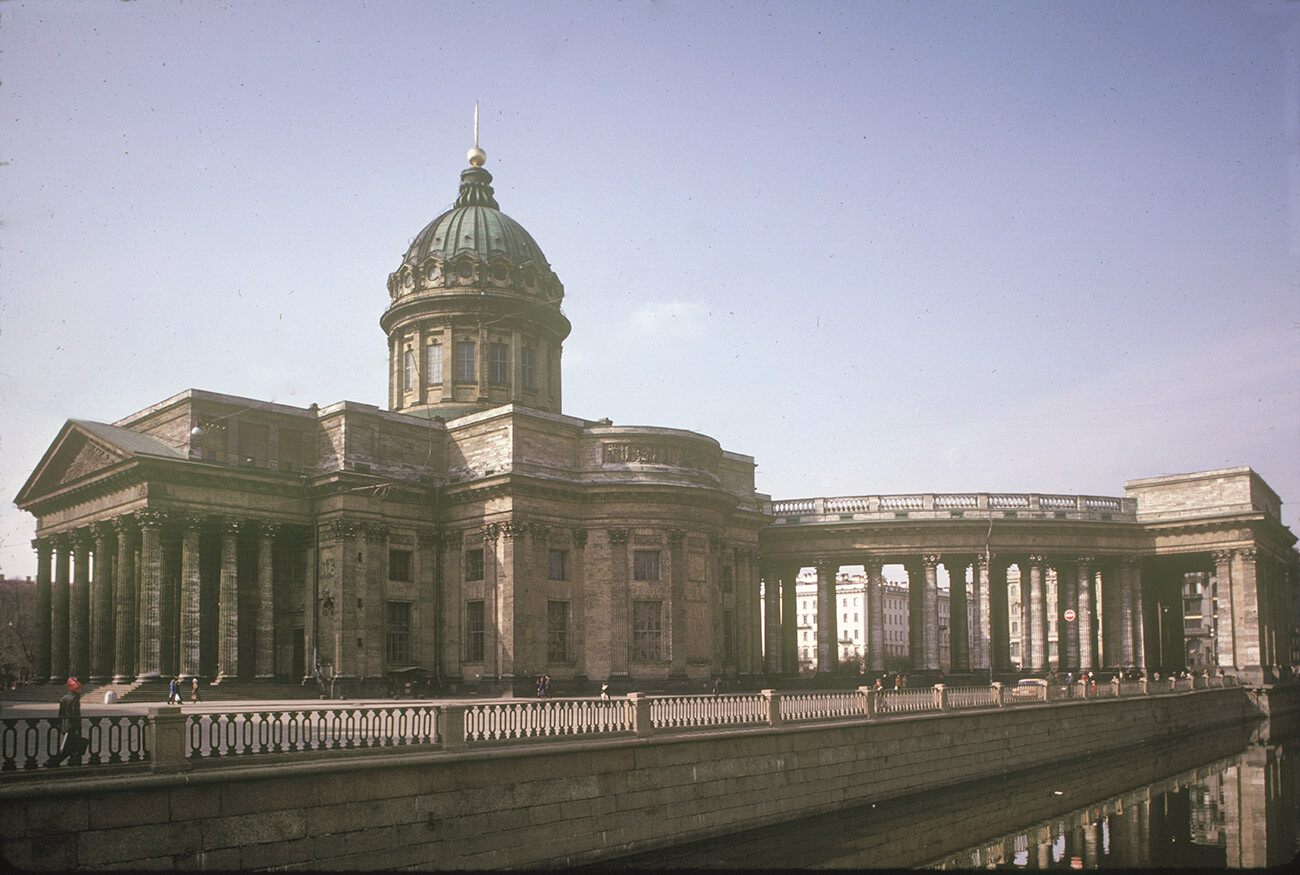
Cathedral of Kazan Icon of the Virgin. Southeast view across Griboedov (formerly Catherine) Canal. April 19, 1984
William BrumfieldAlthough St. Petersburg is renowned for its grandiose baroque and neoclassical architectural ensembles, such as the Winter Palace, the city’s image is equally defined by this stunning church monument in what is called the Russian Revival or “neo-Russian” style. In a grand juxtaposition, one of the city’s greatest Neoclassical monuments - the Cathedral of the Kazan Icon of the Virgin - is located just two blocks away on the same canal.
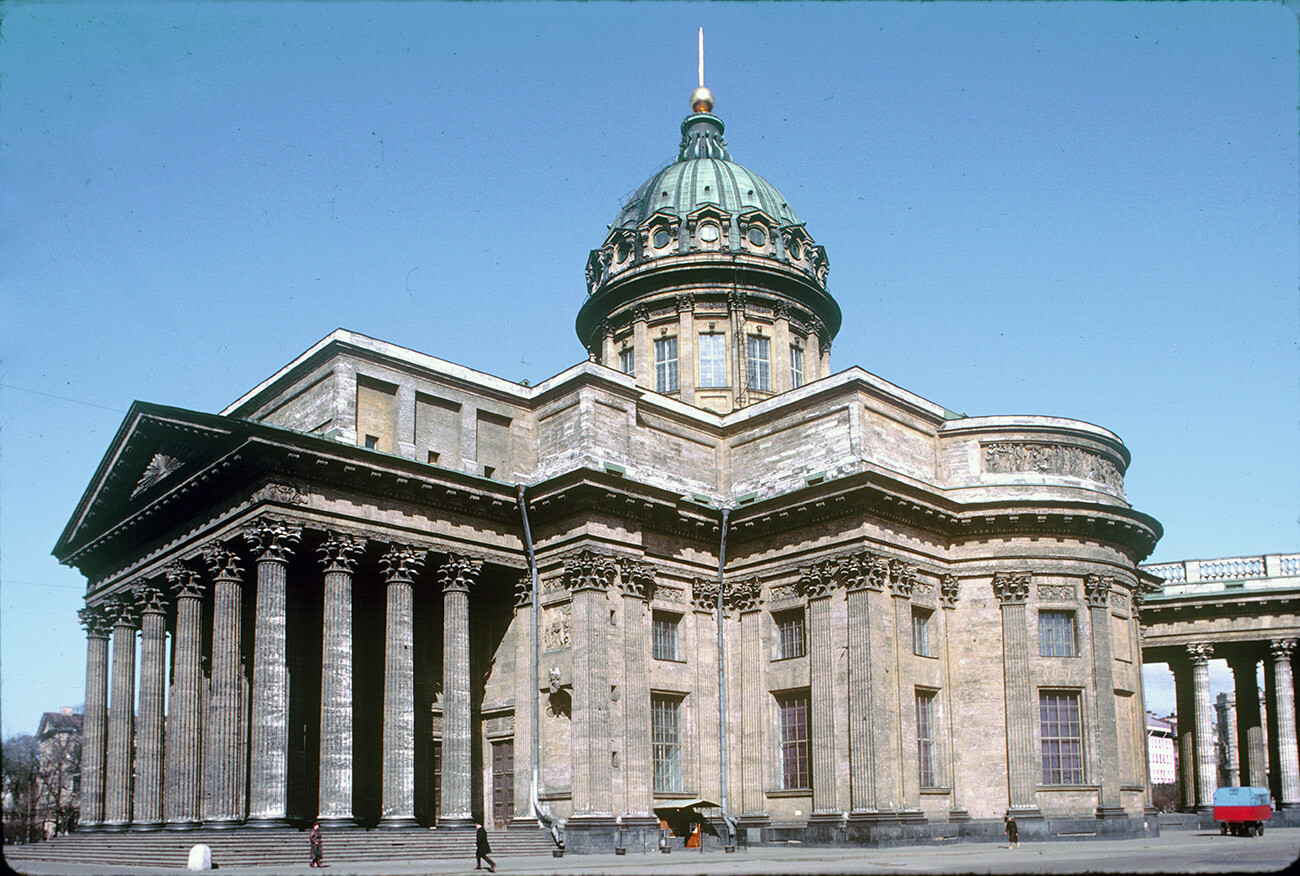
Cathedral of Kazan Icon of the Virgin. Southeast view with south portico. April 9, 1984
William BrumfieldLike the cathedrals of the Moscow Kremlin, St. Petersburg has its shrines to the nation’s history, such as the Cathedral of Sts. Peter and Paul, initiated by Peter the Great in the early 18th century, when it replaced the Kremlin’s Archangel Cathedral as the burial place for Russia’s autocrats. Yet, the Cathedral of Sts. Peter and Paul was located within a closely guarded fortress and, for the first century of its existence, St. Petersburg lacked a generally accessible temple whose architecture would proclaim the luster of the imperial capital.

Cathedral of Kazan Icon of the Virgin. South portico, east side with sculpted panel "The Marriage of Joseph & Virgin Mary," by sculptor Jean-Dominique Rachette. April 9, 1984
William BrumfieldThat need was met with the construction in 1801-11 of the Cathedral of the Kazan Icon of the Virgin, prominently situated at the intersection of the Catherine (now Griboedov) Canal and Nevsky Prospekt, the city's main thoroughfare. Its location and design were carefully planned to command a vital space at the center of the city.
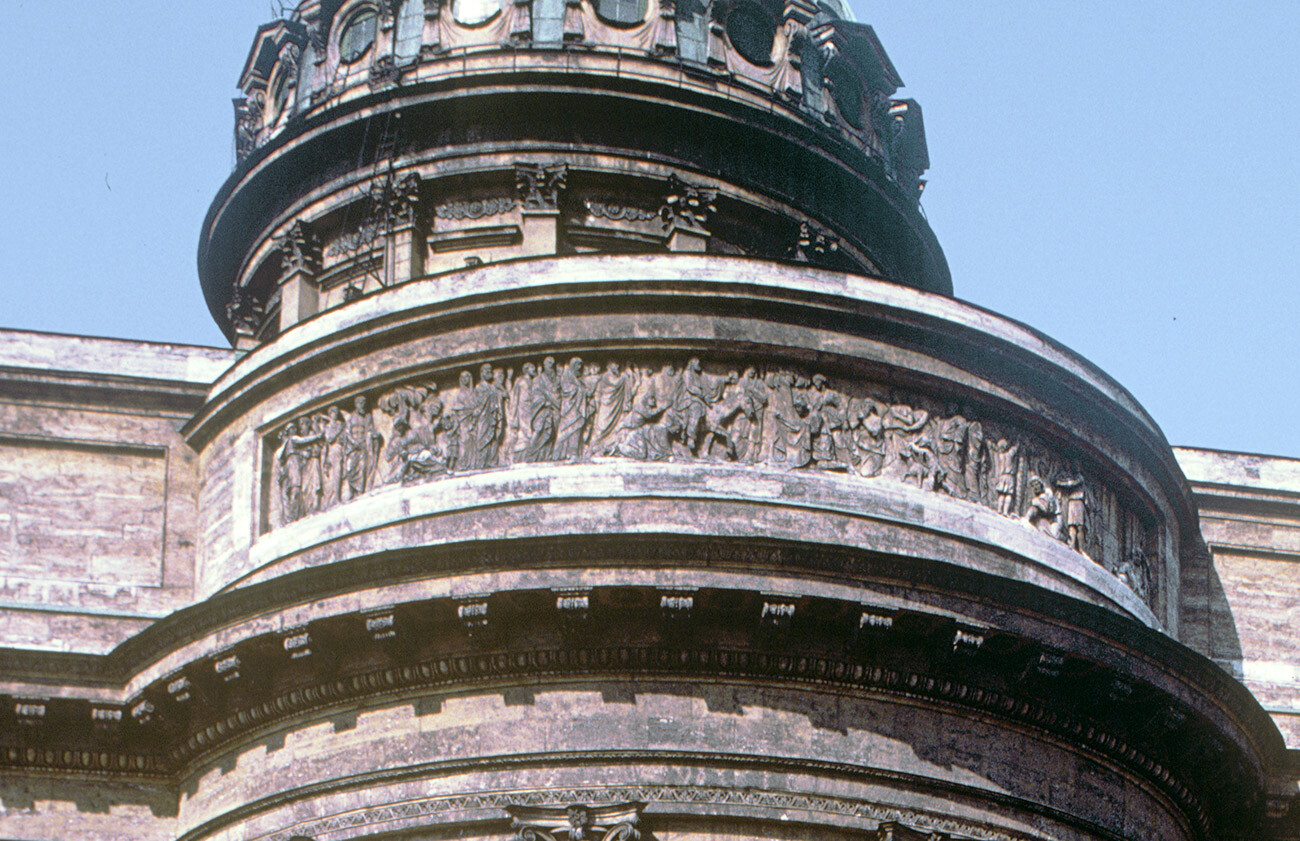
Cathedral of Kazan Icon of the Virgin. East facade with sculpted attic frieze "Entry of Christ into Jerusalem" by sculptor Jean-Dominique Rachette. April 9, 1984
William BrumfieldAs early as the 1780s, there had been plans to rebuild Mikhail Zemtsov’s modest Church of the Nativity of the Virgin on Nevsky Prospekt, the repository of the miraculous Kazan Icon of the Virgin. This icon, frequently copied and one of the most venerated Russian images of Mary holding the infant Jesus, was thought to have been revealed after a fire that destroyed part of the city of Kazan in 1579.
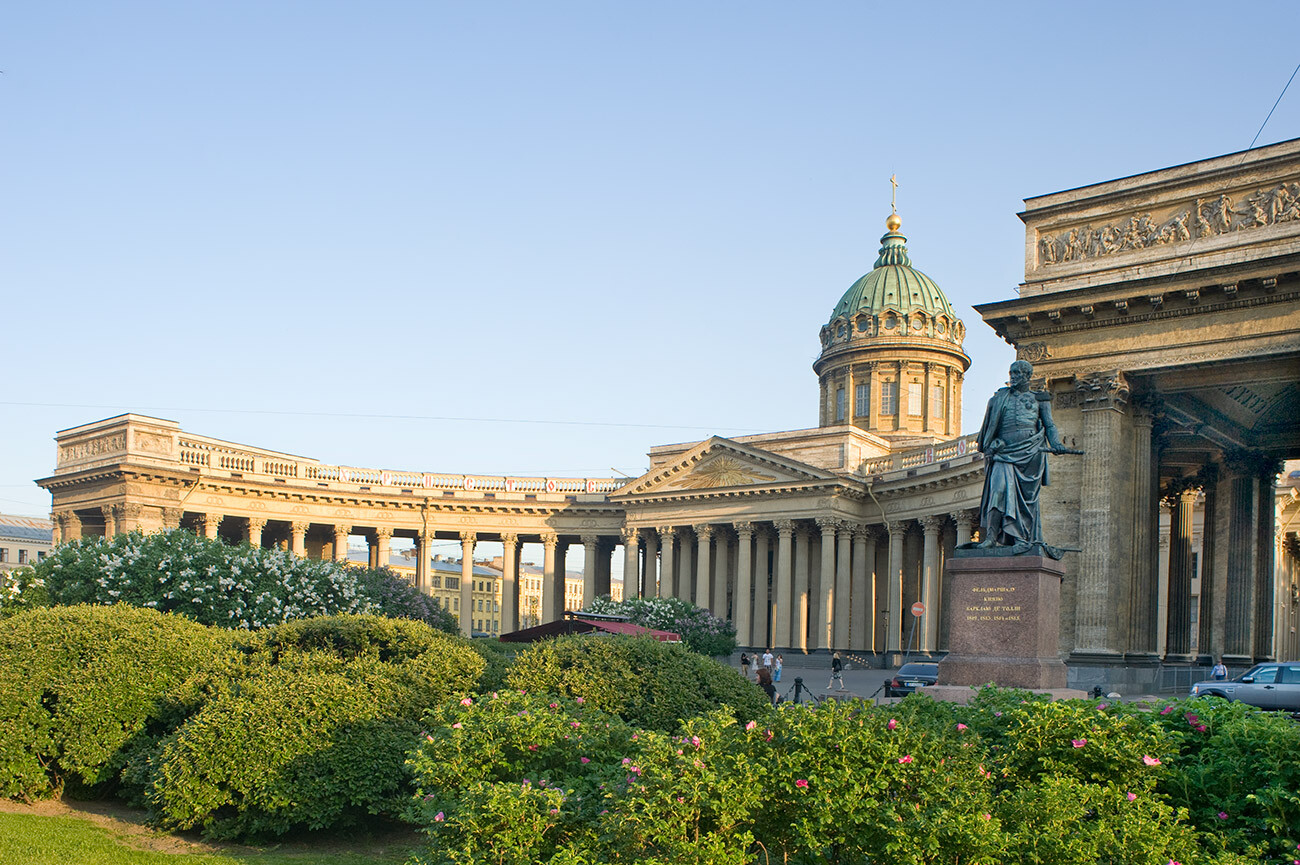
Cathedral of Kazan Icon of the Virgin. Northwest view on Nevsky Prospekt with west end block (right). June 3, 2013
William BrumfieldThe icon’s national significance grew in the early 17th century, when it was believed to have played a role in Russia’s salvation from the dynastic chaos known as the ‘Time of Troubles’. The image was, therefore, closely connected with the Romanov dynasty, founded in 1613, to resolve the dynastic crisis. In 1721, Peter the Great brought one of the early copies of the Kazan Icon to his new capital of St. Petersburg.

Cathedral of Kazan Icon of the Virgin. West end block, north facade attic, frieze "Elevation by Moses of the Bronze Serpent" by sculptor Ivan Prokofiev. June 3, 2013
William BrumfieldSeveral decades later, St. Petersburg underwent an intensive construction phase during the brief reign of Emperor Paul I, from 1796 to 1801. Despite the instability of the five years preceding his assassination, Paul’s reign witnessed the victorious campaign of Alexander Suvorov over the armies of revolutionary France in Italy.
This was also a time of Russian initiatives in the Mediterranean. Paul was chosen Grand Master of the Maltese Order of the Knights of St. John, who had been driven from Malta by Napoleon in 1798. Paul’s idea of a rapprochement between Orthodoxy and Roman Catholicism seems to have influenced the design of the Cathedral of the Kazan Icon, whose decoration frequently displays the Maltese cross.
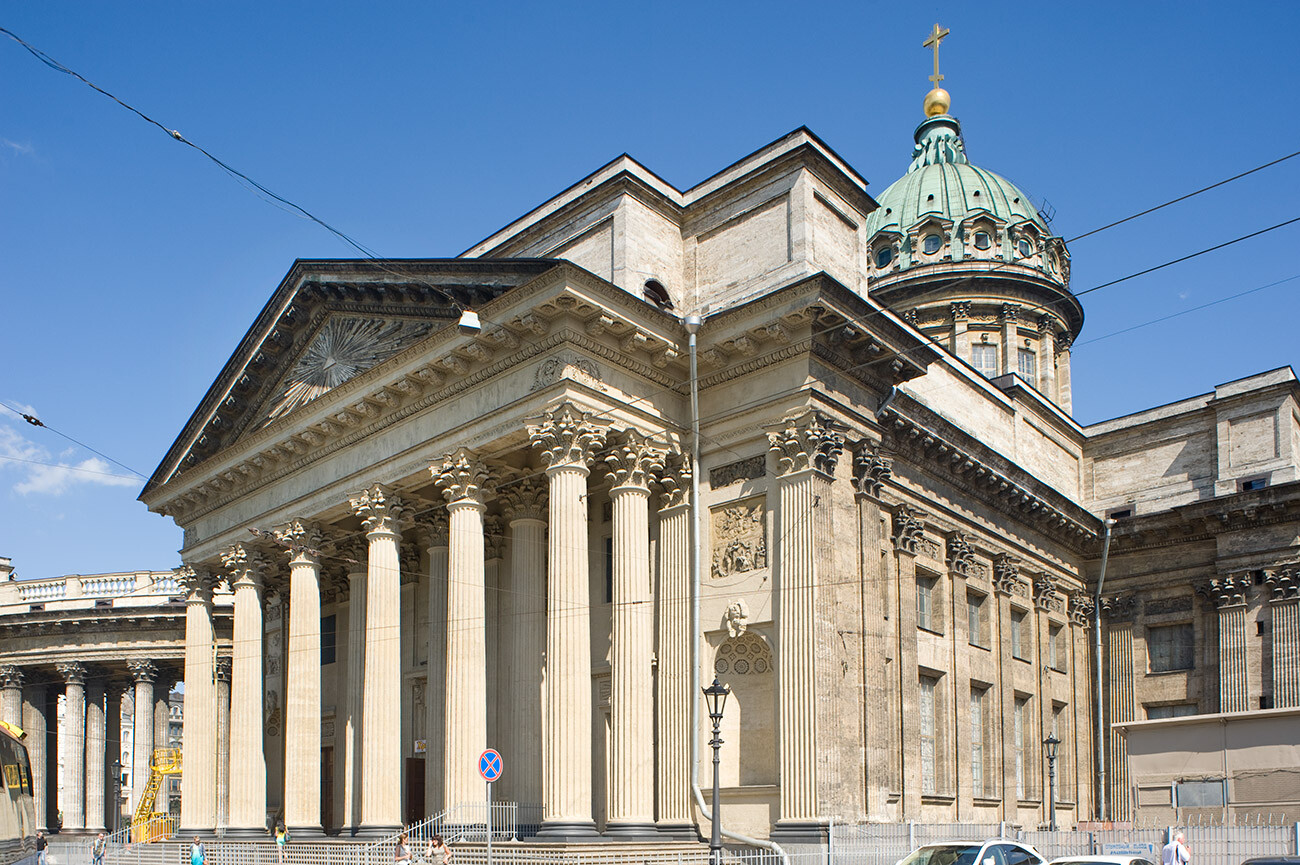
Cathedral of Kazan Icon of the Virgin. West portico with sculpted panel "The Discovery of the Kazan Icon of the Virgin" by sculptor Artemy Anisimov. May 31, 2013
William BrumfieldThe cathedral’s architect, Andrei Voronikhin (1759-1814), was born a serf on a Urals estate of Count Alexander Sergeyevich Stroganov, scion of one of the richest families in Russia. An astute patron of the arts, Stroganov recognized Voronikhin’s talent and brought him to Moscow in 1777, where he studied for two years with master architects Vasily Bazhenov and Matvei Kazakov.
In 1779, Voronikhin was drawn into the Stroganov circle in St. Petersburg and granted his freedom in 1786. He accompanied Alexander Stroganov’s son Pavel on travels in Europe between 1786 and 1790. Before returning to Russia, Voronikhin had private architectural training in Paris.
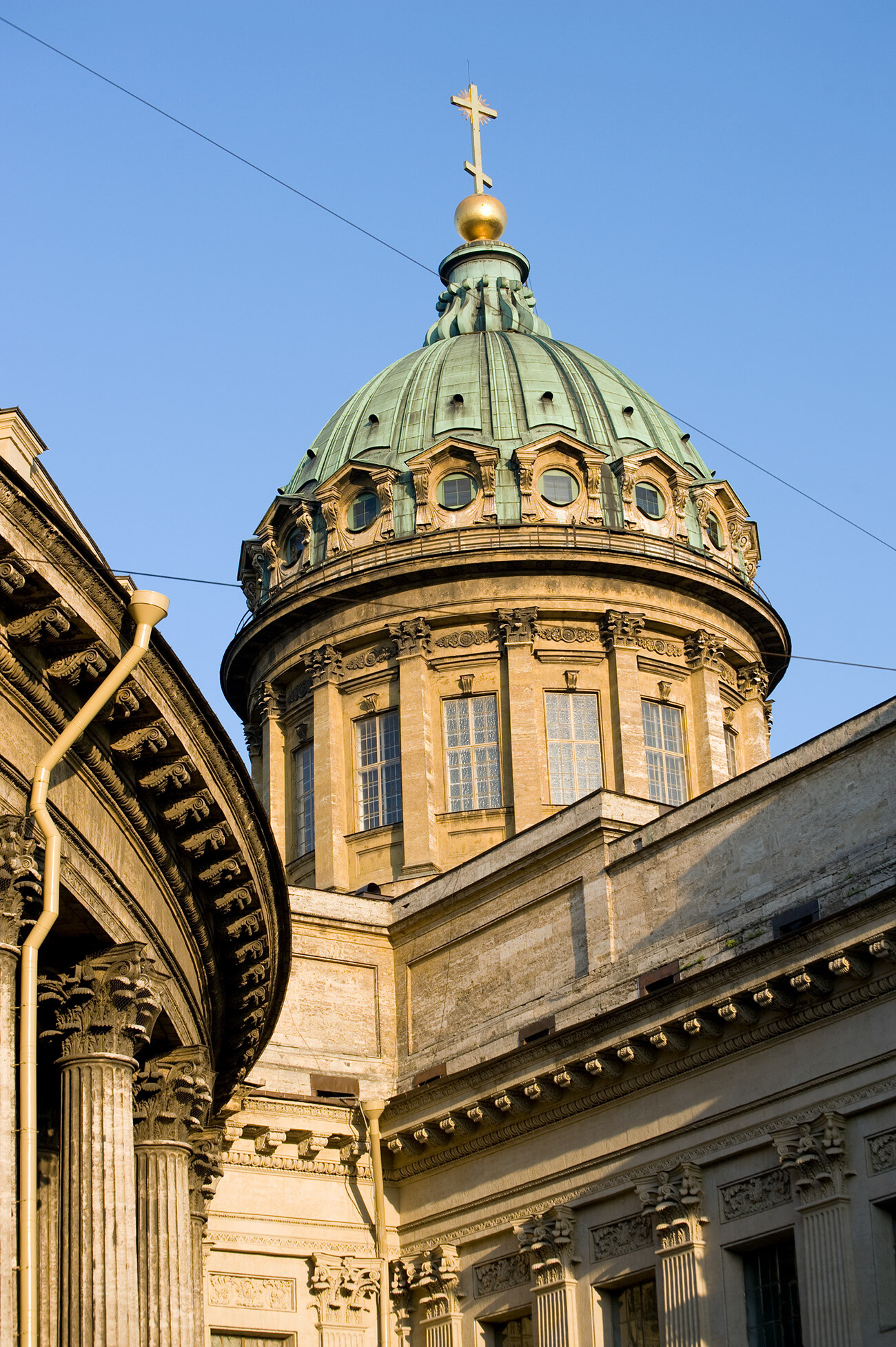
Cathedral of Kazan Icon of the Virgin, west view. Dome with west portico (right) & colonnade. June 3, 2013
William BrumfieldIn 1799, Paul reopened the competition for a new cathedral, whose design was to reflect the grandeur of Rome. Alexander Stroganov headed the construction commission, which promptly chose Voronikhin as the architect. Although Voronikhin's qualifications were questioned, Stroganov's faith in “his” architect proved justified both in the organization of the vast construction project and in the magnificent eloquence of the design itself.
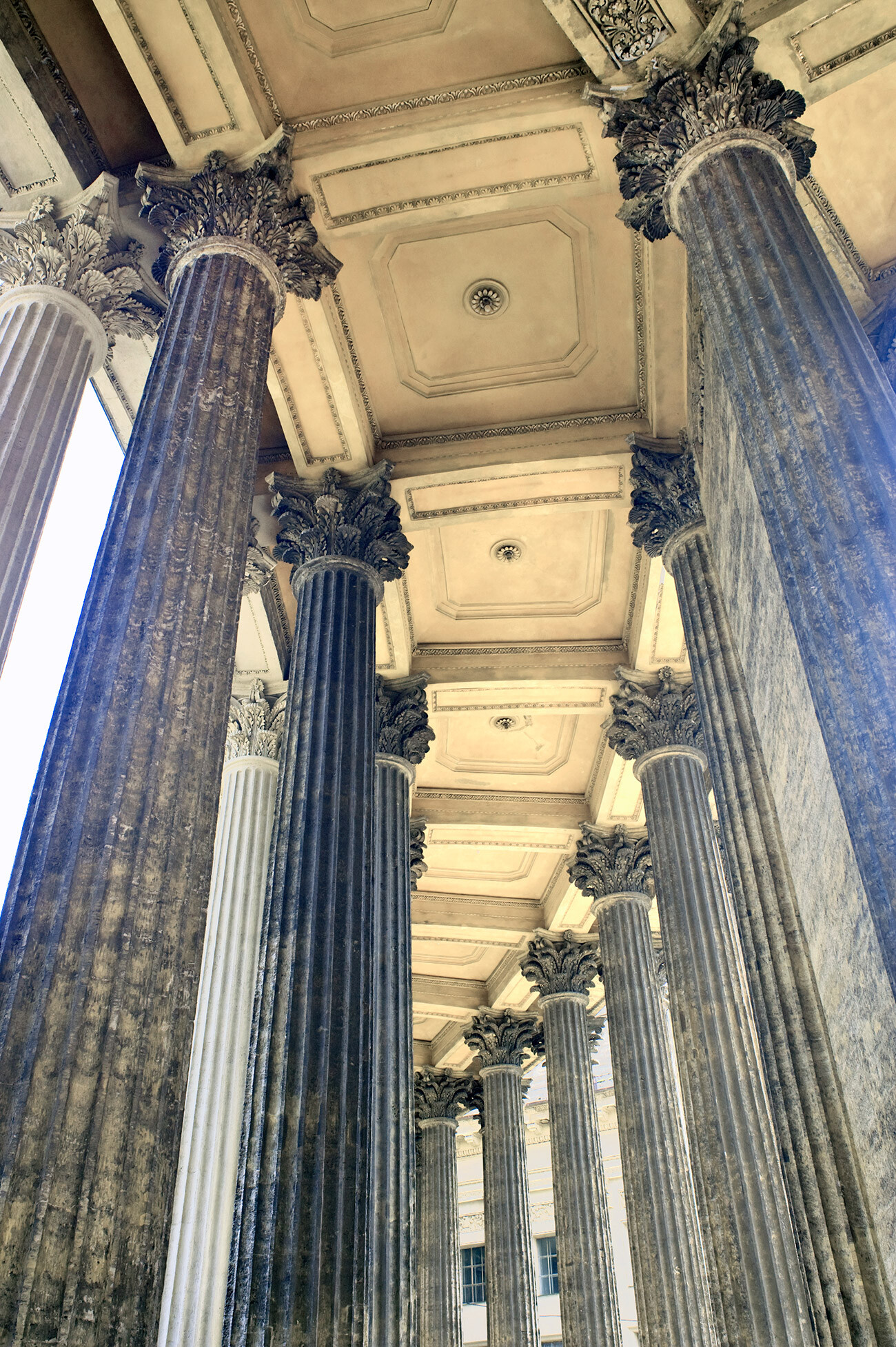
Cathedral of Kazan Icon of the Virgin, west colonnade. May 31, 2013
William BrumfieldThe body of the Kazan Cathedral is in the form of a Latin cross, with Corinthian porticoes on the west, north and south and a semicircular apse on the east. A sculpted frieze above the apse portrays the Entry of Christ into Jerusalem. Capped by a large attic parapet, the cathedral is crowned with a dome above a cylinder (or “drum”) whose pilasters echo the rows of columns below.
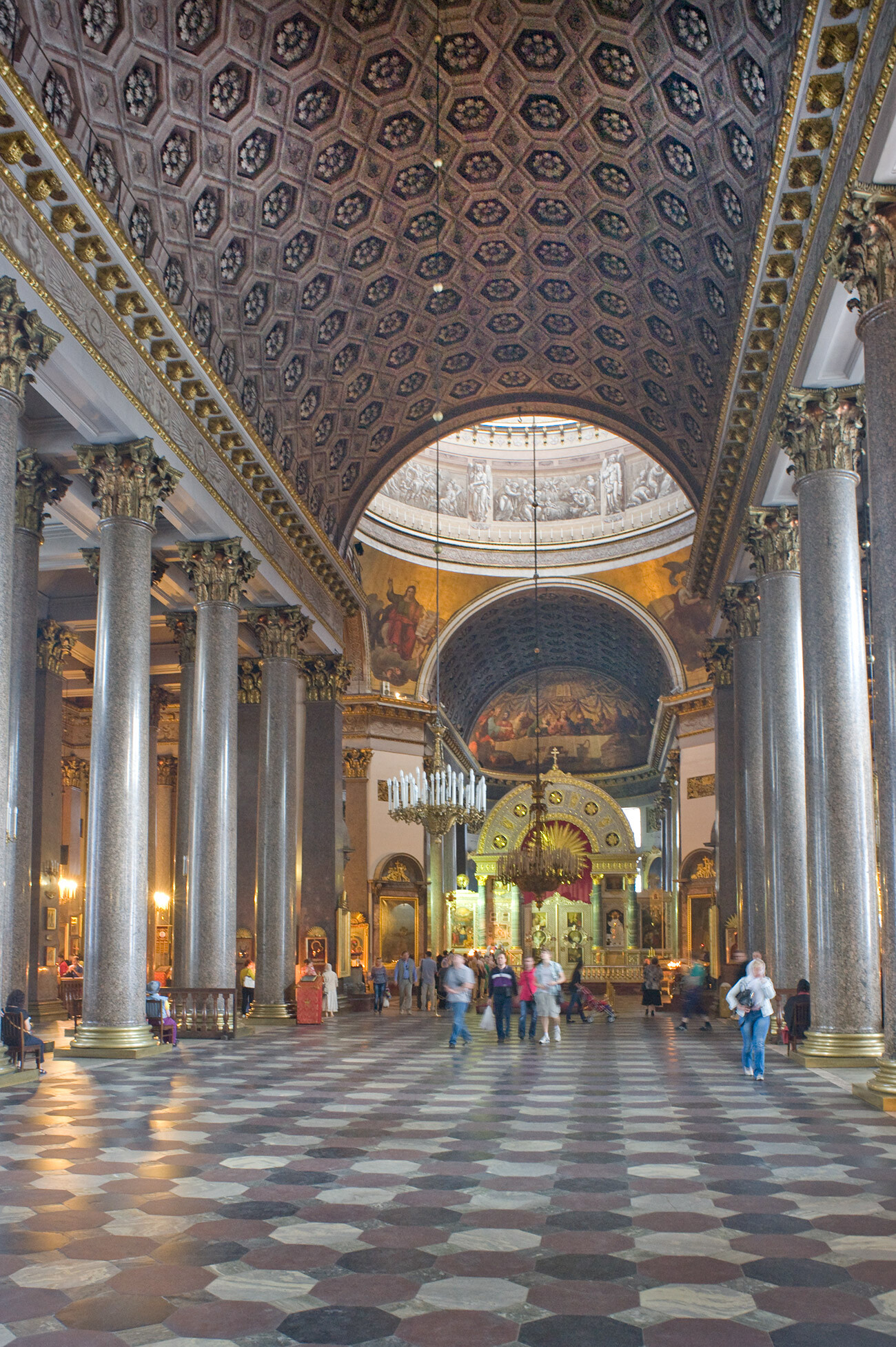
Cathedral of Kazan Icon of the Virgin. Nave, view east toward main altar. May 31, 2013
William BrumfieldThe placement of the cathedral in relation to Nevsky Prospekt demanded an ingenious solution. Because the cathedral’s main (east-west) axis parallels Nevsky Prospekt, the architect created a grand north facade facing the boulevard, with a curved colonnade anchored by massive end blocks on the east and west.
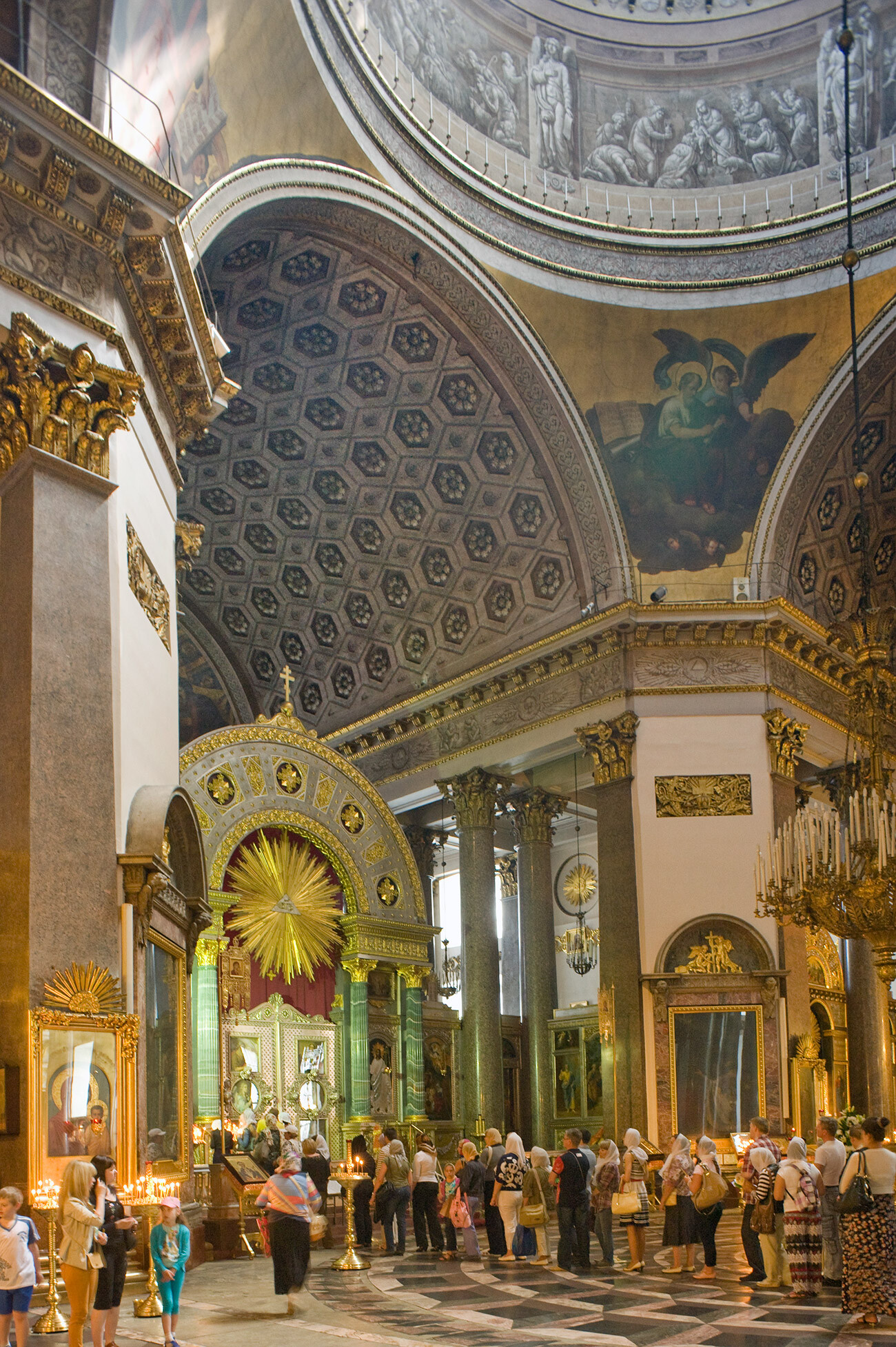
Cathedral of Kazan Icon of the Virgin. Crossing under dome, view southeast toward main altar. Painting of Evangelist Matthew on pendentive. May 31, 2013
William BrumfieldIn the original plan there was to be a matching colonnade on the south side, but because of the cost it remained unbuilt. The main entrance, on the west façade, is tucked behind the north colonnade.
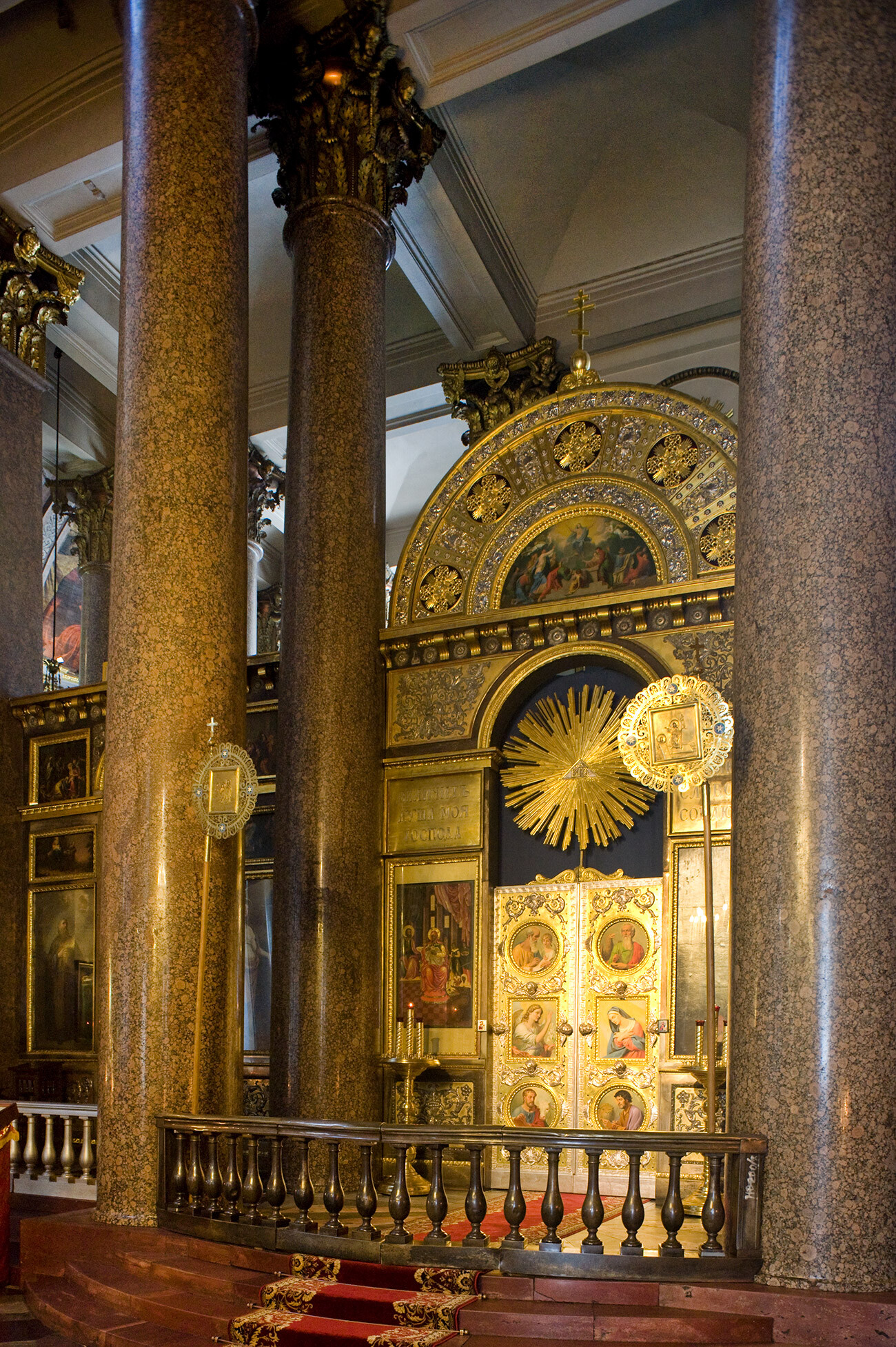
Cathedral of Kazan Icon of the Virgin. South Chapel of Nativity of the Virgin. Icon screen with Royal Gate (entrance to altar). May 31, 2013
William BrumfieldThe brick walls of the structure are surfaced with Pudost stone, a limestone tufa obtained in nearby Gatchina. It is tractable when quarried but hardens on exposure to air, thus providing an ideal substance for detailed sculpting. This quality was used in designing monumental friezes on Biblical subjects for the attics of the east and west end blocks, the apse, and sculpted panels for the three porticoes.
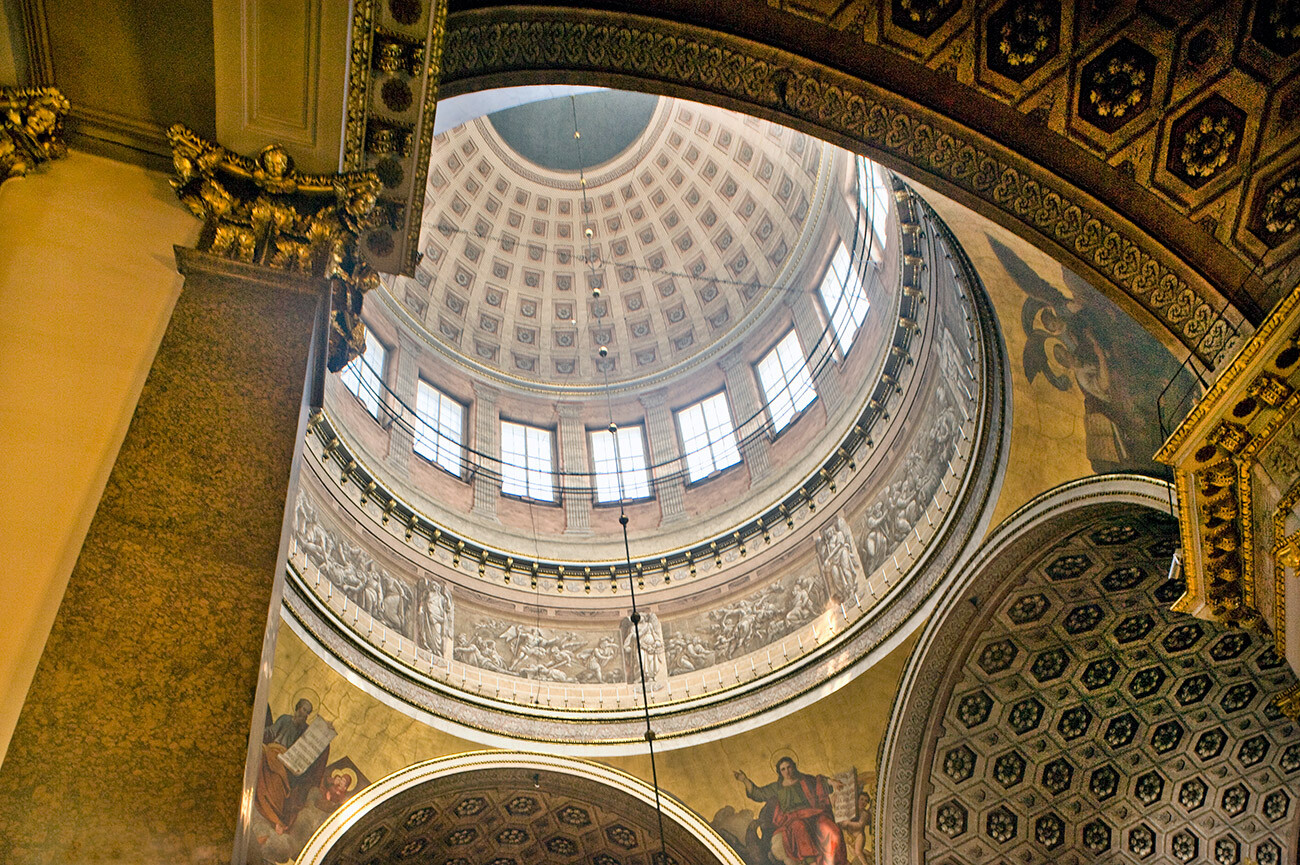
Cathedral of Kazan Icon of the Virgin. Dome, view north. Paintings of Evangelists on pendentives: Luke (left), John, Matthew. Grisaille frieze with scenes from life of Christ and Virgin Mary. May 31, 2013
William BrumfieldThe exterior columns and capitals, arranged in ranks of four, are also of Pudost stone, with various details rendered in granite (three different types), limestone and marble. Bronze was used for statuary, including Saints Vladimir and Alexander Nevsky by Stepan Pimenov on either side of the north portal. The massive doors are surfaced with bronze panels based on Lorenzo Ghiberti’s designs for the Baptistery in Florence.
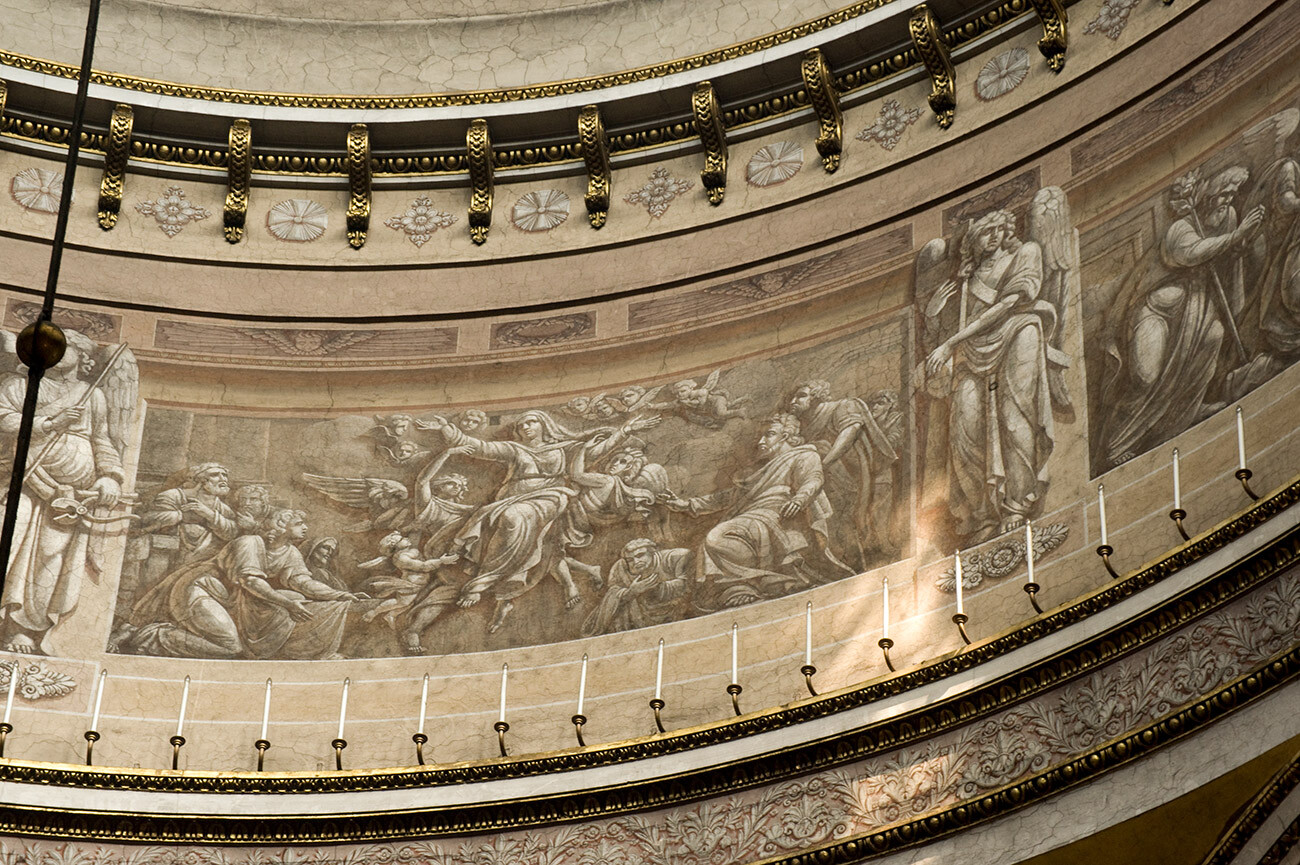
Cathedral of Kazan Icon of the Virgin. Dome, grisaille trompe-l'oeil frieze "Assumption of Virgin Mary". May 31, 2013
William BrumfieldThe magnificent interior is defined by a colonnade of 56 paired Corinthian columns that line the central nave and arms of the structure. The columns (10.7 meters in height) are of polished red Finnish granite with gilded bronze capitals. The barrel vaults display a web of hexagonal coffers with rosettes. The floor is a mosaic of stonework primarily quarried in the Ural Mountains.
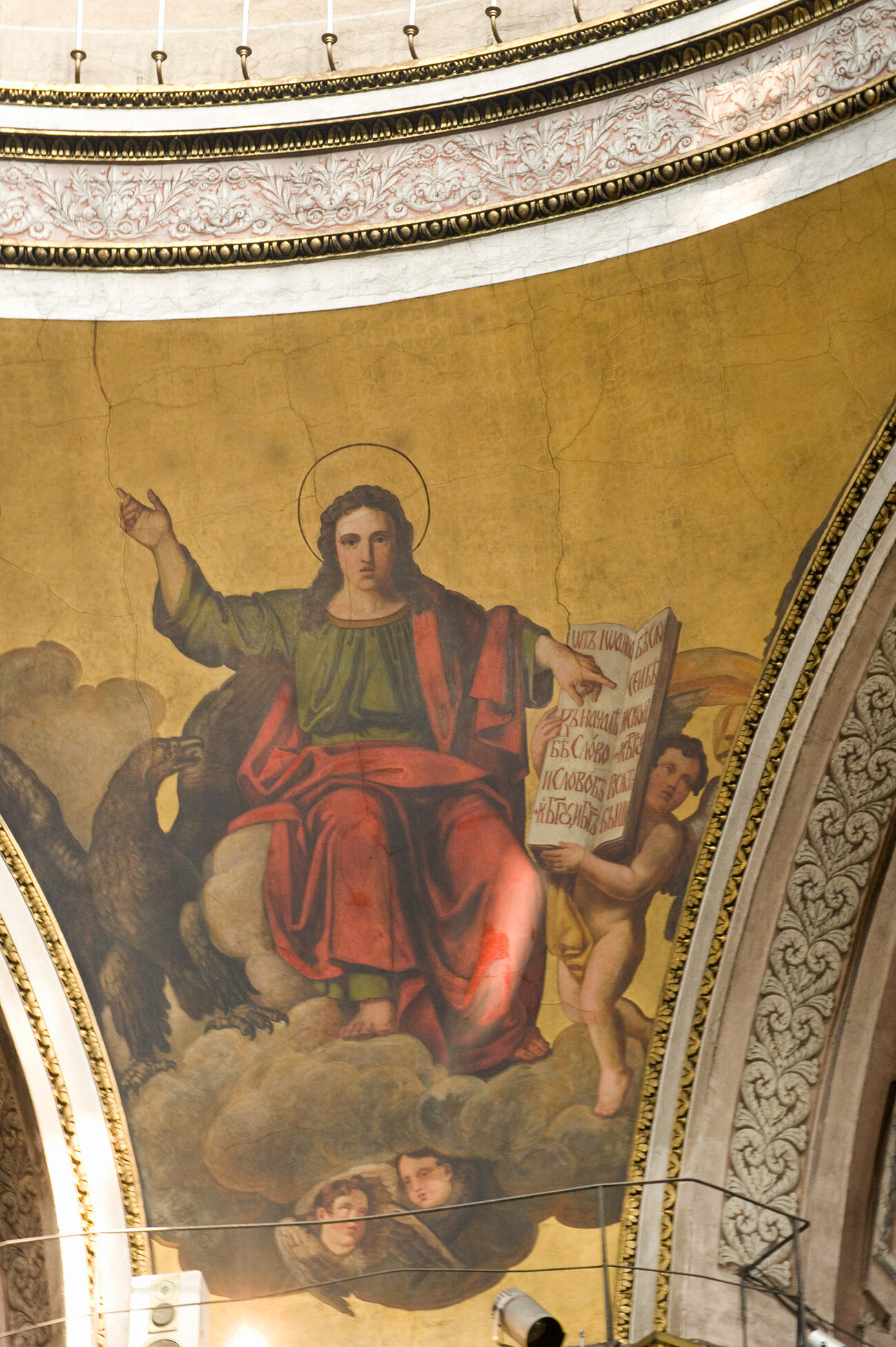
Cathedral of Kazan Icon of the Virgin. Dome, northeast pendentive, painting of Apostle John (with eagle) by Vasily Shebuev. May 31, 2013
William BrumfieldThe interior centers on the space beneath the dome. Massive pylons rise to the cylinder with depictions of the four Evangelists on the pendentives. The drum contains a painted gray frieze (grisaille) in imitation of sculpture depicting scenes from the life of Christ and Mary. The coffered dome consists of a double shell.
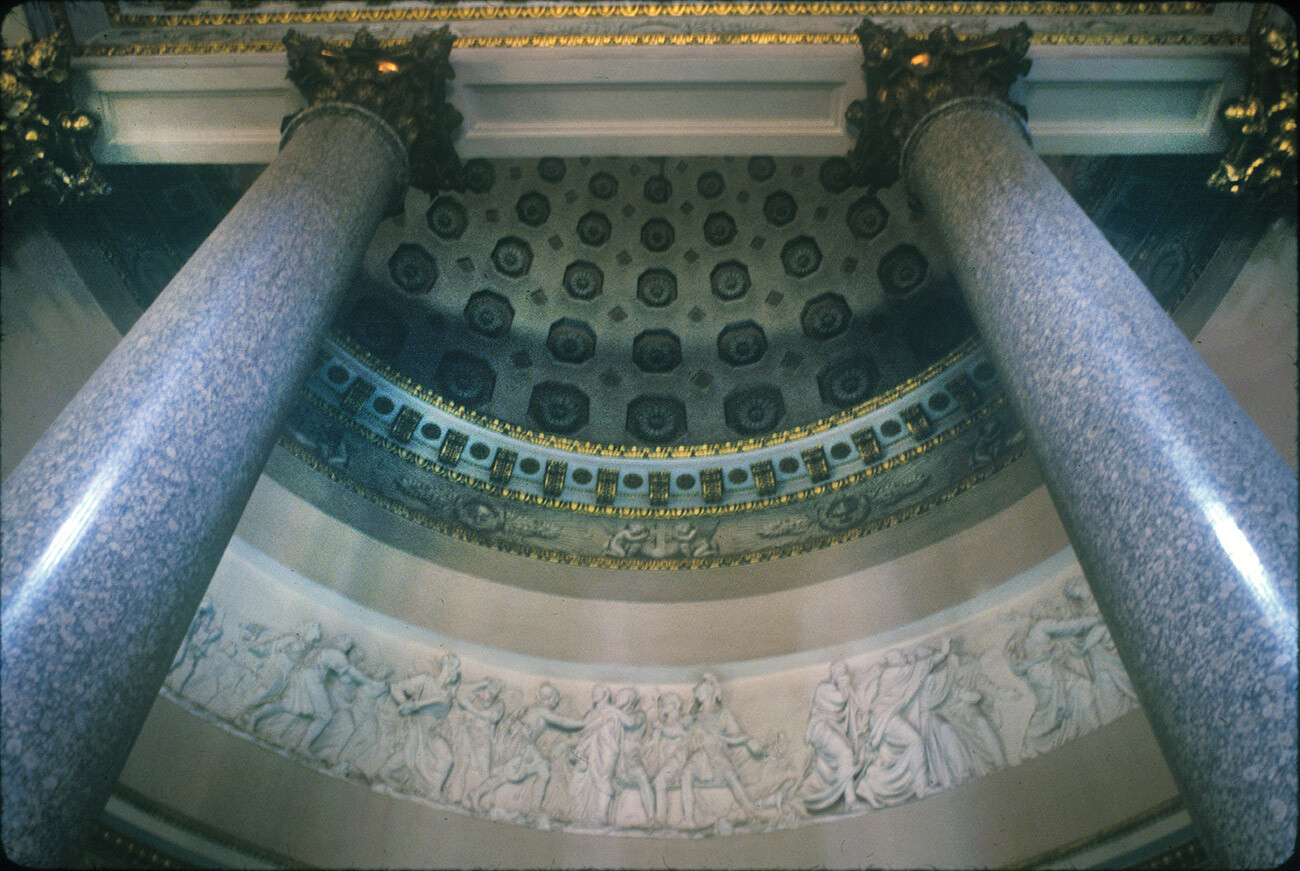
Cathedral of Kazan Icon of the Virgin. North arm, semi-rotunda at north entrance with frieze "The Seizing of Christ in the Garden" by sculptor Jean-Dominique Rachette. April 19, 1984
William BrumfieldThe painting of the interior was supervised by the Imperial Academy of the Arts and included works on canvas as well as on plaster. The icon screens were painted by prominent academic artists such as Vasily Borovikovsky and Andrei Ivanov, father of the renowned artist Alexander Ivanov.
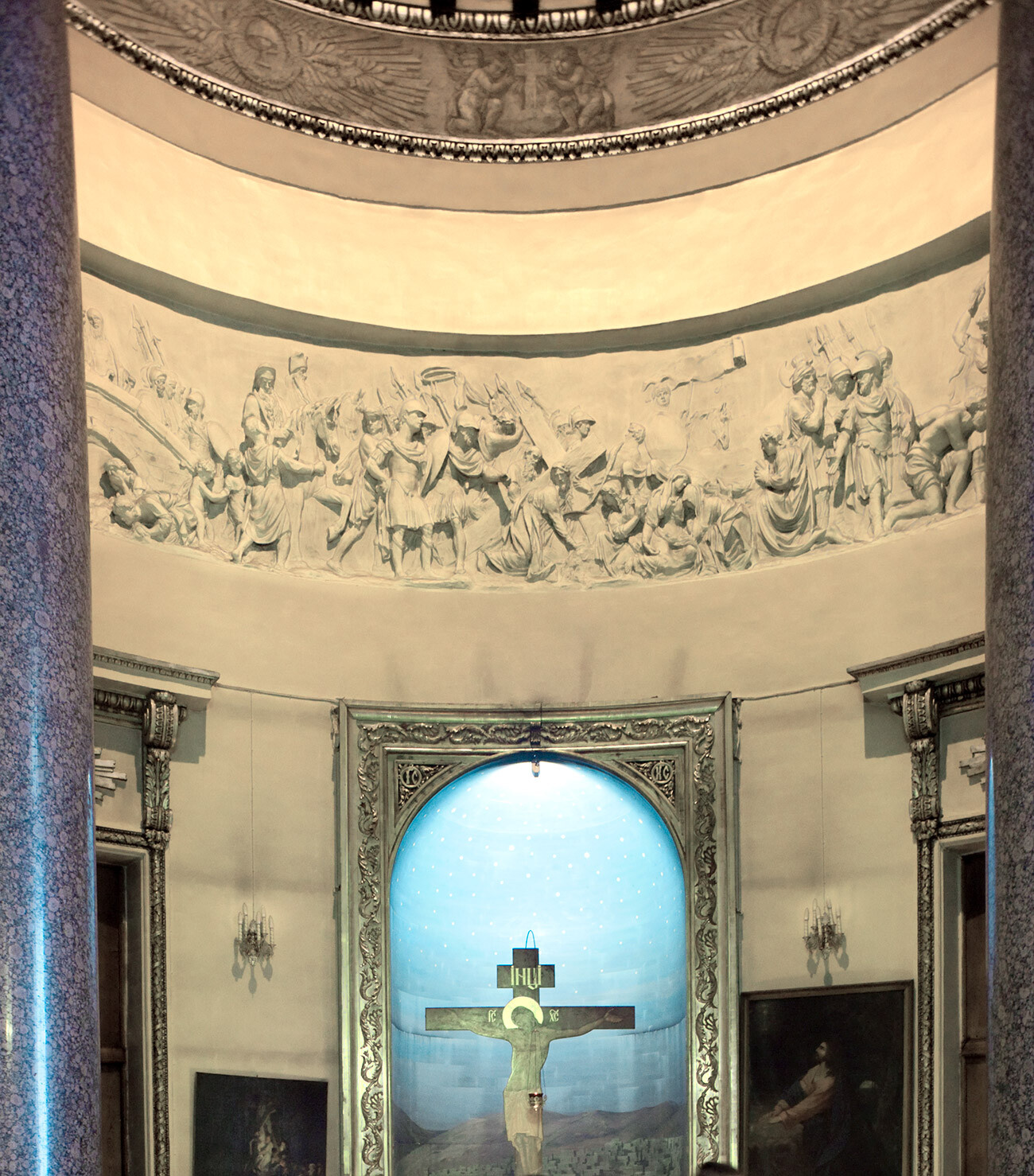
Cathedral of Kazan Icon of the Virgin. South arm, semi-rotunda with frieze "Procession of Christ to Golgotha" by sculptor Feodosy Shchedrin. May 31, 2013
William BrumfieldBy the time of its completion in 1811, the Kazan Cathedral had acquired the aura of a national shrine. Captured French trophies were placed there in 1812 and, in July 1813, the cathedral witnessed the solemn burial of Prince Mikhail Golenishchev-Kutuzov, commander-in-chief of the Russian armies against Napoleon and hero of Leo Tolstoy’s ‘War and Peace’.
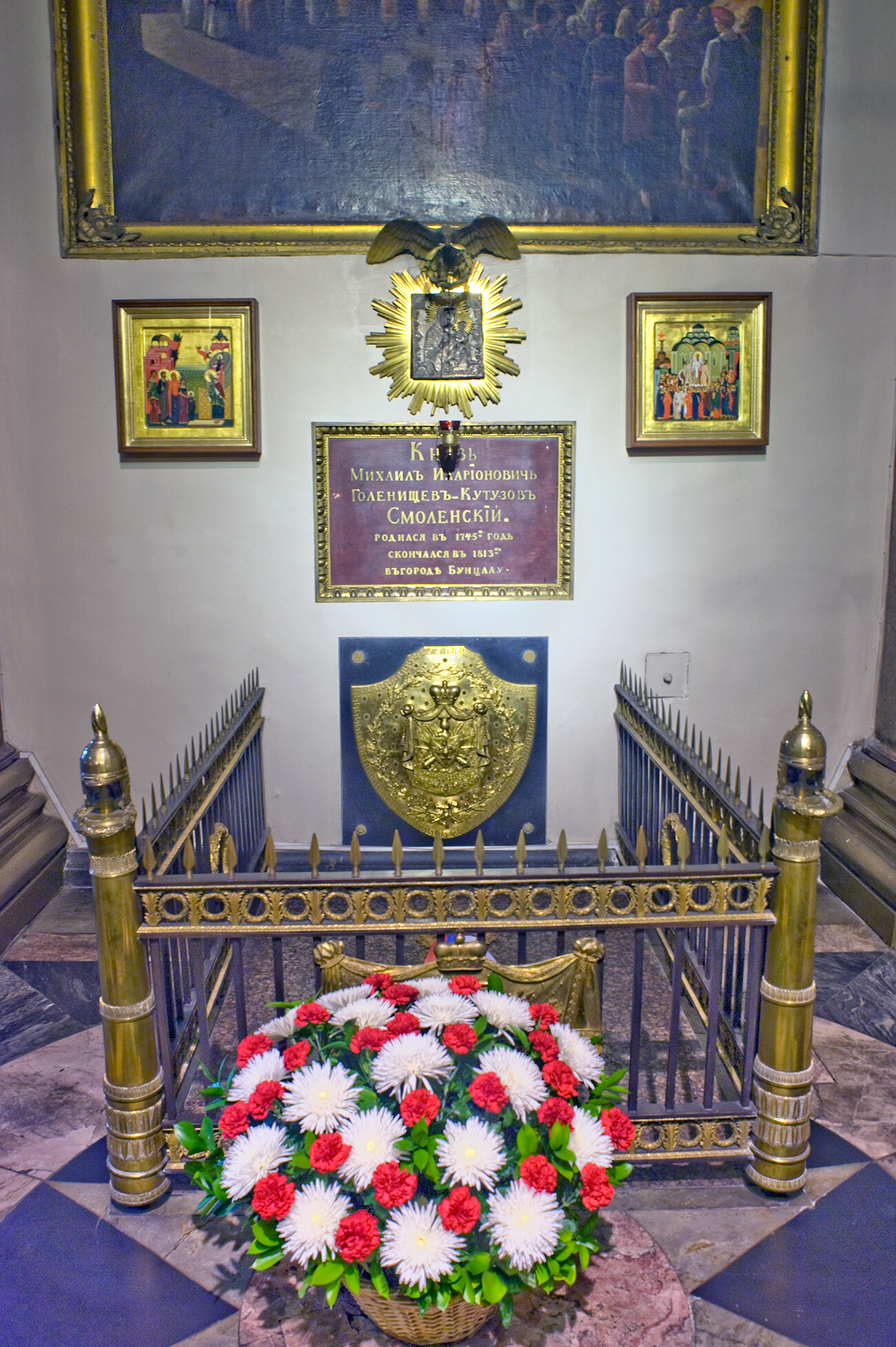
Cathedral of Kazan Icon of the Virgin. North arm, tomb of Prince Mikhail Golenishchev-Kutuzov. May 31, 2013
William BrumfieldThe Kazan Cathedral belongs to a monumental style of classicism epitomized by Saint Peter’s in Rome and continued in Jacques Germain Soufflot’s Sainte Geneviève in Paris (the Panthéon, built in 1755-1792). With its north colonnade the cathedral design integrates architectural form and public space on a magnificent scale.

Cathedral of Kazan Icon of the Virgin. Statue of Prince Michael Barclay de Tolly on Nevsky Prospekt. Right background: Singer Building. May 31, 2013
William BrumfieldFinally, the Kazan Cathedral anchors Nevsky Prospekt at its crossing of the Catherine (Griboedov) Canal. The landmark Singer Building, built across the boulevard in 1902-1904, subsequently joined the cathedral in this role as did the Cathedral of the Resurrection on the Blood. These two shrines, built in such different styles and visible from one another, reflect the turbulent fate of the Romanov dynasty - and of Russia itself.
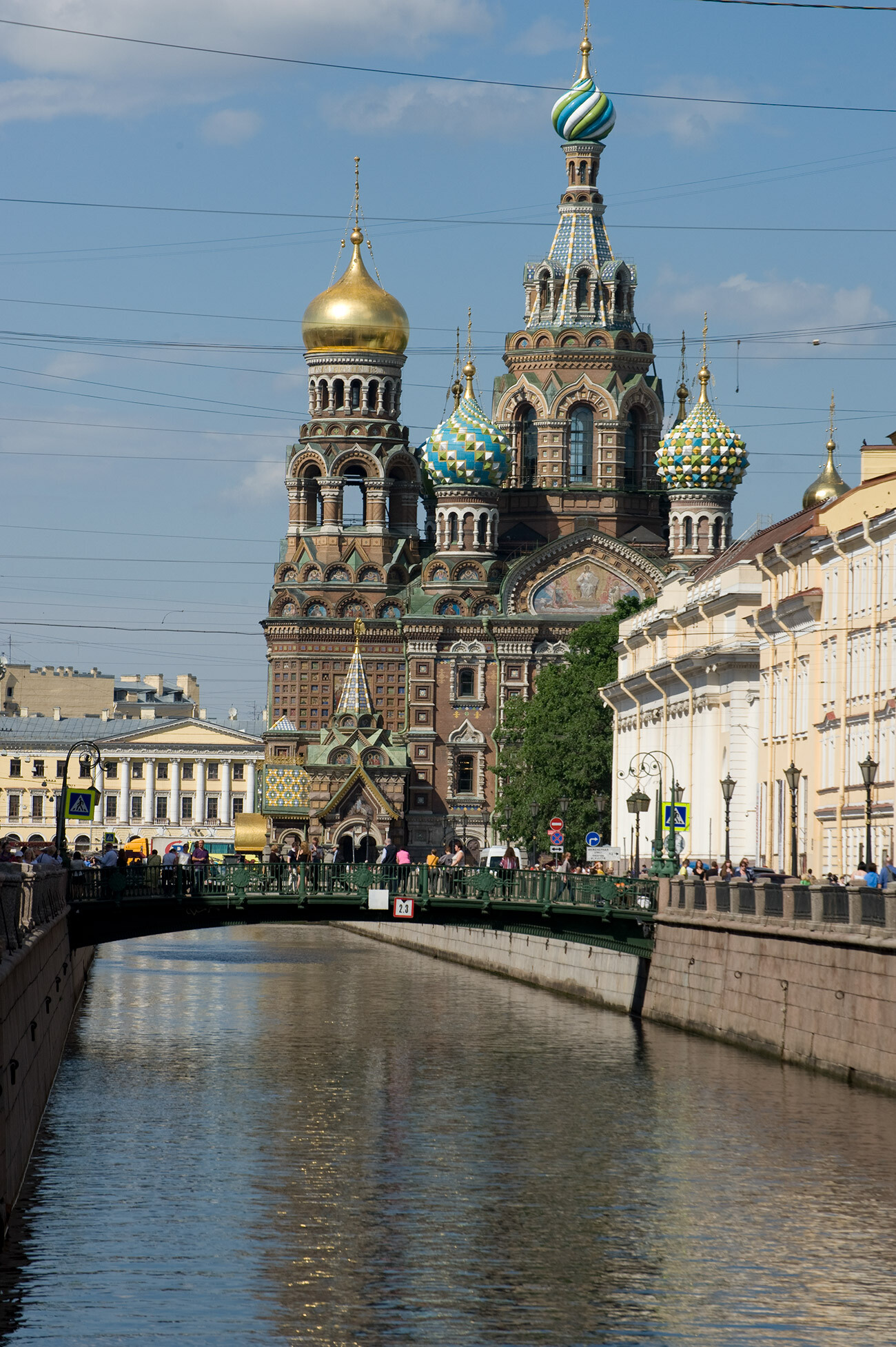
Cathedral of Resurrection of Savior on the Blood. South view from Nevsky Prospekt with Griboedov (formerly Catherine) Canal. May 31, 2013
William BrumfieldIn the early 20th century, Russian photographer Sergey Prokudin-Gorsky developed a complex process for color photography. Between 1903 and 1916, he traveled through the Russian Empire and took over 2,000 photographs with the process, which involved three exposures on a glass plate. In August 1918, he left Russia and ultimately resettled in France where he was reunited with a large part of his collection of glass negatives, as well as 13 albums of contact prints. After his death in Paris in 1944, his heirs sold the collection to the Library of Congress. In the early 21st century, the Library digitized the Prokudin-Gorsky Collection and made it freely available to the global public. A few Russian websites now have versions of the collection. In 1986, the architectural historian and photographer William Brumfield organized the first exhibit of Prokudin-Gorsky photographs at the Library of Congress. Over a period of work in Russia beginning in 1970, Brumfield has photographed most of the sites visited by Prokudin-Gorsky. This series of articles juxtaposes Prokudin-Gorsky’s views of architectural monuments with photographs taken by Brumfield decades later.
If using any of Russia Beyond's content, partly or in full, always provide an active hyperlink to the original material.
Subscribe
to our newsletter!
Get the week's best stories straight to your inbox